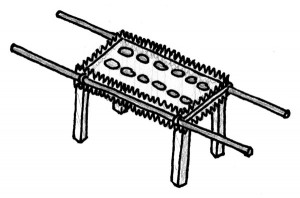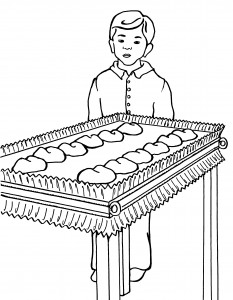The Lord and Aaron went back to the Holy Place, this time to the piece of furniture placed to the right of the Tabernacle. It is called the Table of Shewbread.
Aaron was sitting on the ground next to the table with a big Bible in his hands. The Lord told him to read in Exodus 25:23-25, Thou shalt also make a table of shittim wood: two cubits shall be the length thereof, and a cubit the breadth thereof, and a cubit and a half the height thereof. And thou shalt overlay it with pure gold, and make thereto a crown of gold round about. And thou shalt make unto it a border of an hand breadth round about, and thou shalt make a golden crown to the border thereof round about.
 Each time Aaron read a verse, he looked up to see whether the table he was seeing looked the same as it was written. “Moses really made it exactly as God commanded him,” he thought to himself. When he finished reading, he was ready to listen to what the Lord had to say about this piece of furniture.
Each time Aaron read a verse, he looked up to see whether the table he was seeing looked the same as it was written. “Moses really made it exactly as God commanded him,” he thought to himself. When he finished reading, he was ready to listen to what the Lord had to say about this piece of furniture.
“Aaron,” the Lord spoke to the young boy, “let Me tell you what the measurements of the Table of Shewbread mean: two cubits long and one cubit wide is a square of two, which signifies the witness of the Spirit and the Word. You cannot have the Word without the Spirit for it is the Spirit that enlightens the Word to you. One and a half cubits high still shows the lack in the fullness of God. This experience of eating at the Table of Shewbread is not intended to bring the church to the full stature of Jesus Christ, but it is another experience on the way.”
“Lord, does it mean that if people don’t eat of this table, they cannot enter into the Holy of Holies later on?” Aaron asked.
“This is exactly right, Aaron,” was the reply. “You cannot enter into the Holy of Holies unless you have a vital experience at all the pieces of furniture in the Tabernacle, which also means at the Table of Shewbread.”
“How can I then eat at this table?” Aaron wanted to know, because he really wanted to go all the way.
“I will share it with you soon, My young friend,” the Lord answered, “but before I do, let Me tell you one more special thing about this table – the crown.”
Aaron had already noticed before that there was one crown on the edge of the table turned up and then there was the breadth of a man’s hand as a border. Then, there was another crown turned down. By now he knew that everything in the Tabernacle had a specific meaning. The Lord continued, “The crowns show you that it is a king’s table, but at the same time a place of kingship through suffering and tribulation. The crown turned up is a sign of an exalted position; turned down, it is a sign of humility.”
Aaron thought about other times when the Lord spoke to him about His people being kings and priests. He suddenly realized that in order to be one of them, he had to learn humility. “I still have a long way to go!” he thought. But he knew that with God walking this journey of life by his side, all things were possible.
Aaron then learned that except for the table being made out of wood (representing humanity), everything else on the table was made out of gold: the vessels, the spoons, the bowls, as well as the covers. It showed that the service at this point of God’s dealing with man or with His church is purely of the Spirit, though man is used. The table itself was also overlaid with gold so that no flesh was seen.
“This is how you eat of the table, Aaron,” the Lord explained. “Can you see those twelve loaves of bread set on it? The priests would come in every day and eat it. The bread represents Christ. You must feast on Christ.”
With these words the Lord opened the big Bible to the gospel of John 6:48-51 and handed it to Aaron to read, I am that bread of life. Your fathers did eat manna in the wilderness, and are dead. This is the bread which cometh down from heaven, that a man may eat thereof, and not die. I am the living bread which came down from heaven: if any man eat of this bread, he shall live for ever: and the bread that I will give is my flesh, which I will give for the life of the world.
“You see, Aaron,” the Lord said when Aaron finished reading, “this does not merely represent man feasting on the Word of God from the pages of the Bible, but it represents man feasting on the living Christ Himself. This is what the Table of Shewbread is all about – feeding on Christ.” Then the Lord continued by explaining that we feed on Christ in three dimensions:
1. The Christ within: Christ is in the Holy Spirit. When we receive the Holy Spirit in our spirit, He immediately begins to energize the soul so that the Christ might enter. We have to nurture and obey the still small voice within our soul; and the Holy Spirit will guide us into all truth (see John 16:13).
2. The Christ in the body of believers: Christ comes into the midst of any company of people who are gathered together in His name. He said in Matthew 18:20, For where two or three are gathered together in my name, there am I in the midst of them. And He always keeps His Word. So when we gather together with other believers and we all have Him as our King, He comes and feeds us – He speaks to us in songs and hymns, in prayers, prophecies, visions and words; He uses people to feed one another. 3. The Christ in a third dimension in His presence and person: This means that He walks about our houses, in our bedrooms, dining rooms, living rooms, and in our churches. He is not there as a visitor to whom we show kindness, but as Lord and King. If this is so, than we will feed on Him night and day, sleeping or waking.
3. The Christ in a third dimension in His presence and person: This means that He walks about our houses, in our bedrooms, dining rooms, living rooms, and in our churches. He is not there as a visitor to whom we show kindness, but as Lord and King. If this is so, than we will feed on Him night and day, sleeping or waking.
“With all this said, Aaron,” the Lord kept on, “you have to remember that one thing is to eat, but another thing is to eat the right way. I have spoken in My Word about clean and unclean animals and thus have given you an example of what you are to be like when you come to the Table of Shewbread. I will tell you more about these animals as well as why there are twelve loaves of bread set on the table. But for that you will have to wait until I come the next time…”
Oh, Aaron was so excited! He liked animals and wanted to know which ones were clean and which ones were unclean and what they represented. Yet, he knew he first had to digest what he learned today…
Answer the following questions to see how well you understood this chapter:
- What does the Table of Shewbread represent?
- What does the Table of Shewbread look like?
- What are the measurements of the Table of Shewbread and what do they mean?
- What do the crowns on the Table of Shewbread represent?
- What are the Table of Shewbread and its vessels made out off
- What are the three dimensions of feeding on Christ?